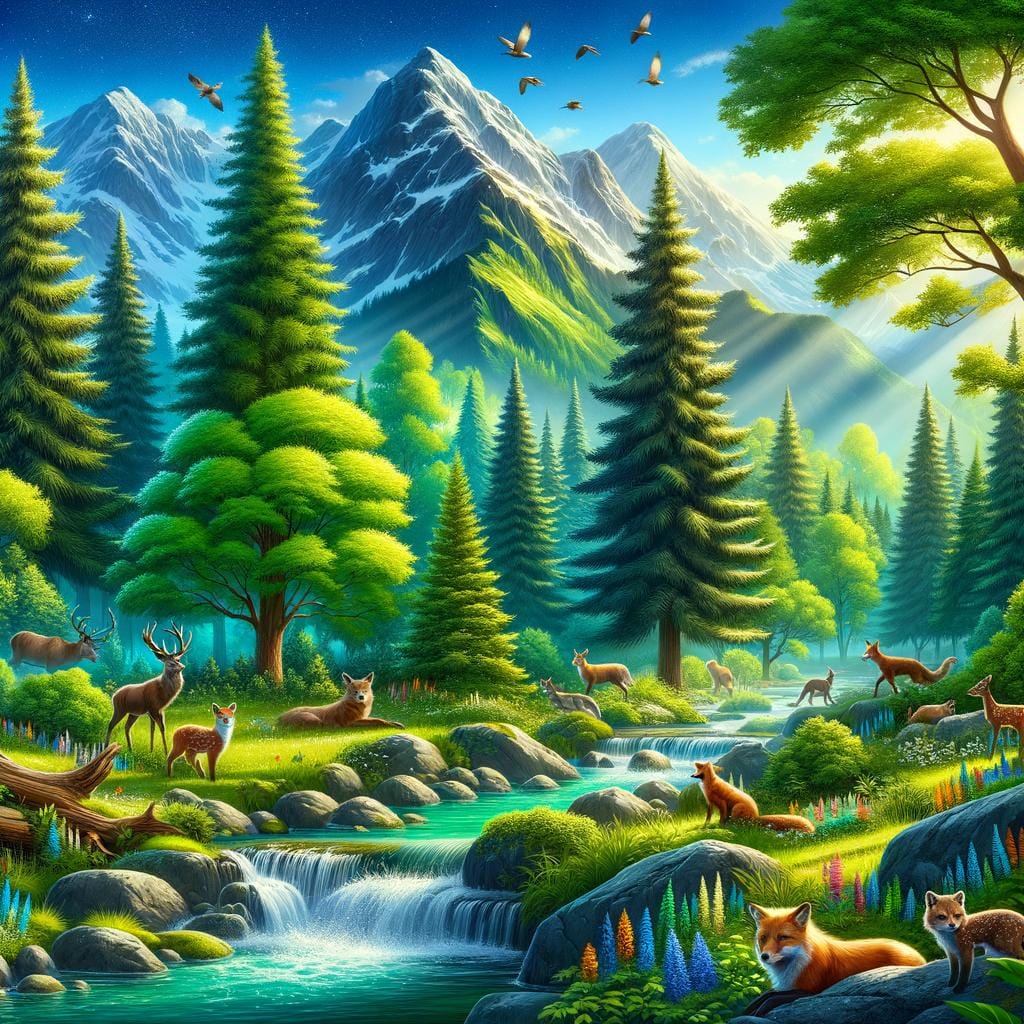Wilderness areas, characterized by their untouched natural landscapes and lack of human development, play a vital role in preserving the biodiversity of our planet. These areas serve as sanctuaries for a wide range of flora and fauna that are crucial to the health of our ecosystems. Defined by their remoteness, intact ecosystems, and minimal human impact, wilderness areas offer a glimpse into the unspoiled beauty of nature.
The designation of wilderness areas aims to protect these vital ecosystems from human interference, allowing them to thrive undisturbed. By safeguarding these pristine environments, we are not only ensuring the survival of countless species but also preserving essential environmental services such as clean air and water. Wilderness areas also provide unique opportunities for scientific research and study, offering valuable insights into the functioning of healthy ecosystems.
Moreover, wilderness areas offer unparalleled recreational opportunities for outdoor enthusiasts seeking solace in nature’s embrace. From hiking and camping to wildlife observation and photography, these natural havens provide endless possibilities for adventure and exploration. As we navigate an increasingly urbanized world, the importance of preserving and protecting wilderness areas cannot be overstated. It is crucial that we recognize the value of these wild spaces and work together to ensure their continued existence for future generations to enjoy and cherish.
History of Wilderness Areas
Wilderness areas have a rich history that dates back to the late 19th and early 20th centuries when the concept of preserving these pristine landscapes began to take shape. The idea of protecting wilderness areas was championed by visionaries like John Muir, who played a pivotal role in advocating for the preservation of natural spaces for future generations.
In 1964, the Wilderness Act was signed into law in the United States, providing legal protection to some of the most untouched and unspoiled lands in the country.
Over time, wilderness areas have evolved from being viewed simply as untouched lands to being recognized as vital sanctuaries for biodiversity and ecosystems. These areas play a crucial role in maintaining ecological balance and providing habitats for a wide variety of plant and animal species. Additionally, wilderness areas serve as important carbon sinks, helping to mitigate climate change by absorbing carbon dioxide from the atmosphere.
As society has become more urbanized and industrialized, preserving wilderness areas has become increasingly important. These natural landscapes offer people an opportunity to reconnect with nature, reduce stress levels, and improve overall well-being. Research has shown that spending time in wilderness areas can have numerous psychological benefits, including reducing anxiety and depression. In today’s fast-paced world, wilderness areas provide a much-needed escape from the hustle and bustle of modern life.
| Year | Event |
|---|---|
| 1964 | Wilderness Act signed into law in the US |
| Late 19th – Early 20th Centuries | John Muir advocates for preservation of wilderness areas |
Benefits of Wilderness Areas
Wilderness areas play a crucial role in maintaining the health of our planet and the well-being of its inhabitants. From towering forests to expansive deserts, these untouched landscapes offer a multitude of benefits that extend far beyond their physical boundaries. One of the most significant advantages of preserving wilderness areas is their environmental impact.
These pristine spaces act as vital carbon sinks, absorbing and storing carbon dioxide from the atmosphere, thus helping to mitigate climate change. Additionally, wilderness areas provide essential habitats for a wide range of plant and animal species, contributing to global biodiversity.
In addition to their environmental benefits, wilderness areas also hold immense economic value. These untouched landscapes attract tourists from around the world who seek solace and adventure in nature. The revenue generated from ecotourism in wilderness areas can support local communities, create jobs, and stimulate economic growth. Furthermore, preserving these natural environments can lead to long-term economic gains through ecosystem services such as clean water provision, soil erosion prevention, and pollination services that benefit agriculture.
Beyond their environmental and economic significance, wilderness areas offer psychological benefits that are essential for human well-being. Studies have shown that spending time in nature can reduce stress levels, improve mental health, and enhance creativity.
Wilderness areas provide a sanctuary away from the hustle and bustle of modern life, allowing individuals to reconnect with themselves and the natural world. By safeguarding these wild spaces, we are not only ensuring a healthier planet but also nurturing our own mental and emotional resilience.
| Environmental | Economic | Psychological |
|---|---|---|
| Essential habitats for biodiversity | Revenue from ecotourism | Reduces stress levels |
| Carbon sinks for mitigating climate change | Ecosystem services like clean water provision | Improves mental health |
| Contribute to global biodiversity | Create jobs in local communities | Enhances creativity |
Threats to Wilderness Areas
Wilderness areas, with their untouched landscapes and diverse ecosystems, face numerous threats in today’s world. These threats not only endanger the unique biodiversity of these areas but also impact the overall health of our planet. From climate change to deforestation and pollution, wilderness areas are under constant pressure from human activities that are altering these pristine environments.
One of the most pressing threats to wilderness areas is climate change. Rising global temperatures, extreme weather events, and melting ice caps are all direct consequences of human-induced climate change. This has profound effects on wilderness areas, causing shifts in habitats, disrupting migration patterns of wildlife, and leading to the decline of certain species. The delicate balance that sustains these ecosystems is being dangerously tipped by the changing climate.
Deforestation is another major threat facing wilderness areas around the world. The clearing of forests for agriculture, logging, and urban development not only destroys vital habitats for countless plant and animal species but also contributes to increased carbon emissions. Deforestation not only diminishes the natural beauty of wilderness areas but also disrupts essential ecological processes such as nutrient cycling and water purification. It is crucial to address this threat to ensure the long-term viability of these valuable natural landscapes.
Pollution poses a significant risk to wilderness areas as well. Whether it’s air pollution from industrial activities or plastic waste littering remote beaches, pollutants can have devastating effects on both wildlife and human visitors to these areas. Contaminants can seep into soils and waterways, affecting plant growth and animal health. Preserving the pristine nature of wilderness areas requires a concerted effort to reduce pollution levels and mitigate its impacts on these fragile ecosystems.
Conservation Efforts
Wilderness areas are crucial for maintaining biodiversity, preserving natural habitats, and offering a sanctuary for wildlife. Various conservation initiatives and organizations around the world work tirelessly to protect and preserve these vital ecosystems. Here are some successful examples of conservation efforts dedicated to safeguarding wilderness areas:
- The Wilderness Society: Founded in the United States in 1935, this organization is committed to protecting America’s public lands and advocating for the designation of new wilderness areas.
- World Wildlife Fund (WWF): The WWF operates globally to conserve the planet’s most ecologically important regions, including many wilderness areas that are under threat from human activities such as logging, mining, and poaching.
- African Parks: This non-profit organization manages national parks and protected areas across Africa with the goal of restoring biodiversity, combating illegal wildlife trade, and promoting sustainable development in local communities.
These conservation initiatives employ various strategies such as advocacy campaigns, habitat restoration projects, scientific research, community engagement, and education programs to ensure the long-term survival of wilderness areas. By raising awareness about the value of these pristine landscapes and implementing effective conservation measures, these organizations play a crucial role in safeguarding our planet’s natural heritage for future generations.
In addition to these large-scale initiatives, there are also numerous local grassroots organizations and volunteer groups dedicated to preserving wilderness areas at a community level. These efforts often focus on land stewardship practices, monitoring wildlife populations, removing invasive species, and promoting eco-friendly tourism in order to strike a balance between human needs and environmental protection within wilderness areas.
Through collaborative efforts at all levels – from international NGOs to individual volunteers – we can collectively work towards a sustainable future where wilderness areas thrive alongside human communities.
Adventure in the Wild
Preparing for Your Wilderness Adventure
Before embarking on a journey into the wilderness, it is essential to adequately prepare yourself. Research the area you plan to visit, familiarize yourself with the local rules and regulations, and ensure you have the necessary supplies and equipment for your trip. Consider factors such as weather conditions, terrain difficulty, wildlife encounters, and emergency protocols. Remember to leave no trace by packing out all your trash and following Leave No Trace principles to minimize your impact on the environment.
Responsible Outdoor Ethics
When venturing into wilderness areas, it is crucial to practice responsible outdoor ethics to protect these delicate ecosystems. Stay on designated trails to avoid damaging vegetation and disturbing wildlife habitats. Respect wildlife by observing them from a safe distance and never feeding them.
Avoid picking flowers or disturbing rocks as these actions can disrupt the natural balance of these ecosystems. By practicing Leave No Trace principles such as disposing of waste properly and minimizing campfire impacts, you can help preserve wilderness areas for future generations.
Sustainable Adventure Practices
To ensure that future generations can continue to enjoy wilderness areas, it is important to engage in sustainable adventure practices. Choose eco-friendly gear made from recycled materials or opt for rental options instead of purchasing new equipment.
Support wilderness conservation efforts by volunteering with local organizations, participating in clean-up initiatives, or donating to causes that protect vulnerable ecosystems. By promoting sustainability in outdoor recreation, we can all play a part in preserving the beauty and biodiversity of wilderness areas for years to come.
Biodiversity Hotspots
Biodiversity is a critical component of wilderness areas, encompassing the wide variety of plant and animal species that inhabit these pristine ecosystems. From towering trees to elusive wildlife, wilderness areas are often considered biodiversity hotspots due to the immense richness of species they support. These diverse flora and fauna play interconnected roles that contribute to the overall health and resilience of these ecosystems.
Flora in Wilderness Areas
Within wilderness areas, you can find a stunning array of plant life, ranging from ancient towering trees in old-growth forests to delicate wildflowers carpeting meadows. Each plant species serves a specific function within its ecosystem, whether it be providing food and shelter for animals, stabilizing soil and preventing erosion, or contributing to the oxygen cycle through photosynthesis. Protecting wilderness areas ensures that these vital plants continue to thrive and maintain ecological balance.
Fauna in Wilderness Areas
Wilderness areas are also home to a rich tapestry of wildlife, from majestic apex predators like wolves and bears to tiny insects crucial for pollination. These diverse animal populations have evolved over centuries to adapt to their habitats, forming intricate food webs and relationships with other species. By safeguarding wilderness areas, we protect not only individual animal species but also preserve the complex interactions that sustain entire ecosystems.
Importance of Protecting Ecosystems
The conservation of biodiversity in wilderness areas is paramount for maintaining healthy ecosystems worldwide. These ecosystems provide essential services such as carbon sequestration, water purification, and climate regulation-all of which benefit both nature and human communities. By preserving these intricate webs of life in wilderness areas, we ensure the continued existence of countless species while safeguarding the wellbeing of our planet as a whole.
Future of Wilderness Areas
As we look towards the future of wilderness areas, it is clear that there are both challenges and opportunities ahead. The growing human population and increasing demands for resources have put immense pressure on these wild places, threatening their very existence. Climate change, deforestation, pollution, and habitat destruction remain major threats to the delicate balance of ecosystems within wilderness areas.
Despite these challenges, there are also opportunities to protect and even expand wilderness areas. Conservation efforts have shown that with dedicated initiatives and the support of organizations and governments, it is possible to preserve these valuable landscapes for future generations. By raising awareness about the importance of wilderness areas and implementing sustainable practices, we can work towards creating a more harmonious relationship between humans and nature.
In order to secure the future of wilderness areas, it is crucial for us to prioritize conservation efforts and adopt policies that promote sustainable use of natural resources. By fostering a deeper connection with the natural world and recognizing the invaluable benefits provided by wilderness areas, we can ensure their protection for generations to come.
Let us commit to being responsible stewards of these precious ecosystems and continue working towards a future where wilderness areas thrive in all their beauty and diversity.
Frequently Asked Questions
What Defines a Wilderness Area?
A wilderness area is typically defined as a natural environment that has not been significantly altered by human activity. It is characterized by its undeveloped, remote, and pristine condition, often providing habitat for a variety of plants and wildlife.
Where Is There Wilderness in the US?
The United States is home to many wilderness areas, ranging from national parks to designated wilderness areas on public lands. States like Alaska, California, Utah, and Wyoming have vast expanses of wilderness that offer opportunities for outdoor recreation and conservation.
What Is an Example of Wilderness?
One example of a renowned wilderness area in the US is the Boundary Waters Canoe Area Wilderness in Minnesota. This protected area encompasses over a million acres of pristine lakes, forests, and waterways perfect for canoeing, camping, and enjoying nature in its untouched state.

An avid outdoor enthusiast, writer, and environmental advocate who has spent over two decades exploring the world’s most breathtaking landscapes. With a background in environmental science and a passion for adventure, Frances combines her love for nature with her talent for storytelling to inspire others to embark on their own outdoor journeys.





